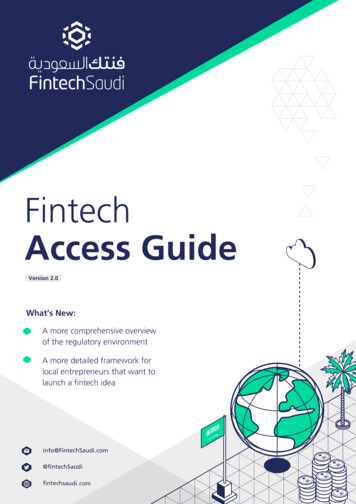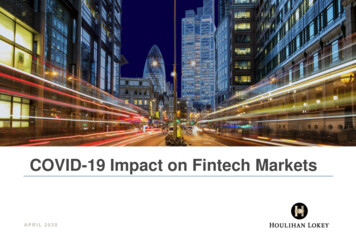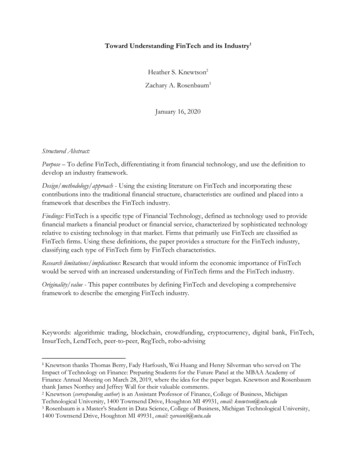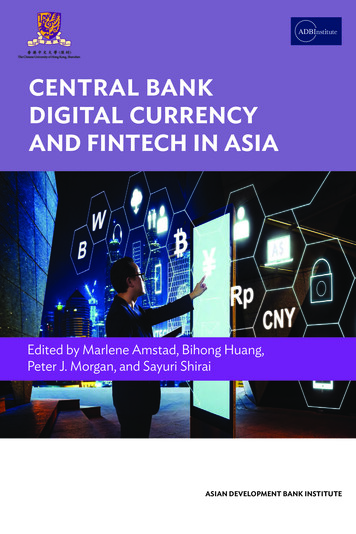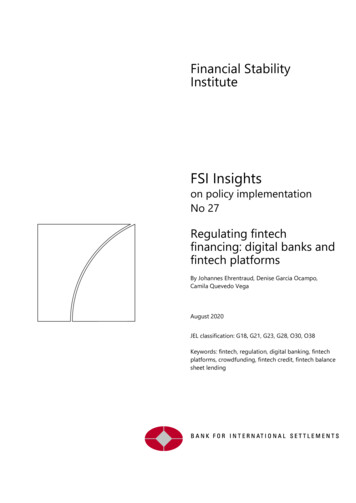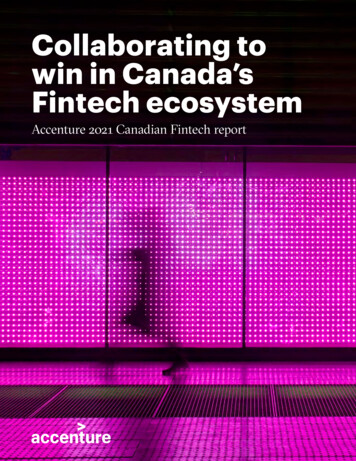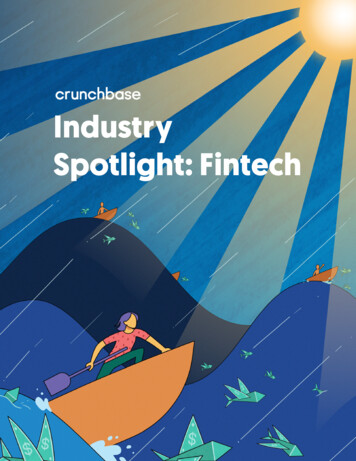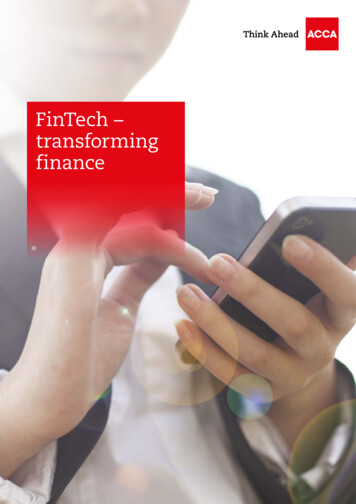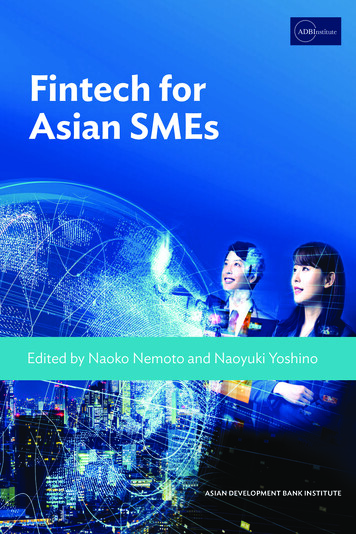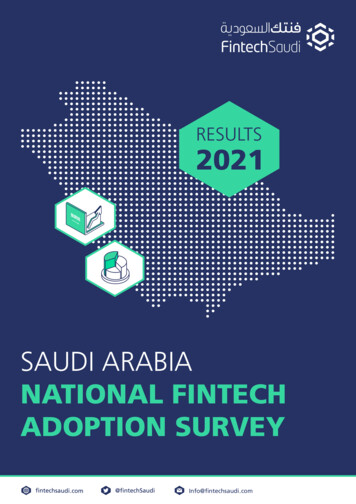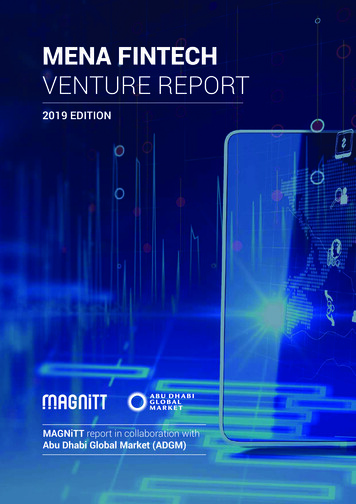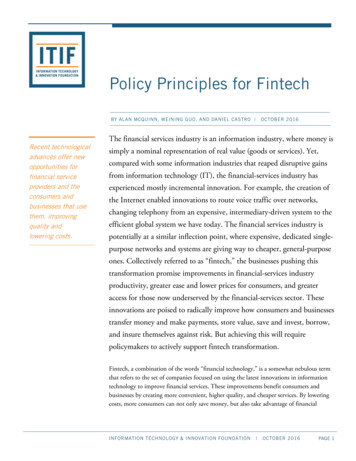
Transcription
Policy Principles for FintechBY ALAN MCQUINN, WEINING GUO, AND DANIEL CASTRO Recent technologicaladvances offer newopportunities forfinancial serviceproviders and theconsumers andbusinesses that usethem, improvingquality andlowering costs.OCTOBER 2016The financial services industry is an information industry, where money issimply a nominal representation of real value (goods or services). Yet,compared with some information industries that reaped disruptive gainsfrom information technology (IT), the financial-services industry hasexperienced mostly incremental innovation. For example, the creation ofthe Internet enabled innovations to route voice traffic over networks,changing telephony from an expensive, intermediary-driven system to theefficient global system we have today. The financial services industry ispotentially at a similar inflection point, where expensive, dedicated singlepurpose networks and systems are giving way to cheaper, general-purposeones. Collectively referred to as “fintech,” the businesses pushing thistransformation promise improvements in financial-services industryproductivity, greater ease and lower prices for consumers, and greateraccess for those now underserved by the financial-services sector. Theseinnovations are poised to radically improve how consumers and businessestransfer money and make payments, store value, save and invest, borrow,and insure themselves against risk. But achieving this will requirepolicymakers to actively support fintech transformation.Fintech, a combination of the words “financial technology,” is a somewhat nebulous termthat refers to the set of companies focused on using the latest innovations in informationtechnology to improve financial services. These improvements benefit consumers andbusinesses by creating more convenient, higher quality, and cheaper services. By loweringcosts, more consumers can not only save money, but also take advantage of financialINFORMATION TECHNOLOGY & INNOVATION FOUNDATION OCTOBER 2016PAGE 1
services and have greater access to capital; this includes those traditionally underserved bythe financial industry. 1Many fintech companies are experimenting with new business models. For example,companies such as Taulia Inc. offer alternative-lending services, such as supply chainfinance, which gives businesses easier access to capital to help with paying their bills whilethey wait for their customers’ payments to process. Similarly, peer-to-peer lendingmarketplaces, such as Prosper, establish direct channels between borrowers and lenders,taking a small fee for each transaction. Alternative lending is not the only business-modelinnovation; however, fintech companies are also changing their business models forpayments, transfers, personal finance, and insurance.Fintech companies, including start-ups and established financial-services organizations, alsooffer solutions that are reducing costs and boosting the performance of financial services,such as by eliminating intermediaries. For example, crowdfunding platforms connectentrepreneurs directly with small investors, circumventing the traditional banking systemand reducing intermediation costs associated with bank loans. Optimistic about thepotential benefits of fintech, investors poured 22.3 billion into fintech start-upsworldwide in 2015, an increase of 75 percent from the year before. 2As a result, competition is increasing in the fintech sector. In 2015, the Economistestimated that there were over 4,000 active fintech start-ups, and more than a dozen arevalued at over 1 billion. 3 McKinsey estimates that new entrants will increasingly battle forcustomers with incumbents over the next decade, with the top five banking businesses (i.e.,consumer finance, mortgages, lending, retail payments, and wealth management) at risk oflosing between 20 and 60 percent of their profits by 2025. 4 Existing financial institutionshave also embraced fintech, although some at a slower pace. The percentage of banks withan innovation strategy—a plan to use advancements in technology to gaincompetitiveness—increased from 37 percent in 2009 to 73 percent in 2015. 5 Somefinancial institutions are forming strategic partnerships with technology companies. 6Others have set up their own venture capital firms to acquire or invest in fintech start-ups,have created innovation labs, incubator and accelerator programs, or have in-housedevelopment departments to develop technological solutions. 7There are a number of challenges confronting the development and adoption of fintechfirms’ services. Fintech companies face a complex regulatory environment that wasdesigned for older business models and is slow to adopt change. As fintech firms operateinternationally, they must also contend with restrictions on where they can store andtransmit data and with regulations designed to protect domestic incumbents. And thebroader financial-services sector continues to face a number of evolving security threats,from data breaches to large-scale theft and fraud.INFORMATION TECHNOLOGY & INNOVATION FOUNDATION OCTOBER 2016PAGE 2
To address these challenges and capture the benefits of financial innovation, policymakersshould work to encourage the growth of fintech. This report offers 10 principles to guidepolicymakers in their approach to this innovative new sector:1.2.3.4.5.6.7.8.9.10.Support fintech transformation.Work to ensure that regulations encourage innovation in financial services.Remove duplicative regulations in financial services.Regulate fintech at the national level.Use regulatory enforcement actions to incentivize fintech companies toprotect consumers.Create tech-neutral rules for fintech.Create a level playing field between incumbents and new entrants.Promote fintech cybersecurity.Support standards development and financial data interoperability.Promote international harmonization of laws affecting the financialservices sector.PRODUCTIVITY POTENTIAL FROM FINTECHThe financial services industry has a long history of using IT for innovations. In the 1950s,the Diners’ Club and American Express—then a mail-delivery company—broughtconsumers the first credit cards to ease the burden of carrying cash. 8 In the late 1960s,banks introduced self-service ATMs to improve customer convenience and make theirtellers more efficient. 9 In the 1970s, stock exchanges began to replace manual floor-tradingwith electronic stock-trading to make trading faster and cheaper. 10 In the 1980s, banksbegan experiments with online banking, using computers and networks to allow consumersto make bank transactions whenever they wanted. 11 In the 1990s, banks began embracingInternet banking, and in the 2000s, most adopted mobile banking. 12Because of the adoption of IT, labor productivity—the increase in output produced byworkers given a unit of effort—has increased across the financial-services sector. Forexample, U.S. commercial banking labor productivity grew by 153 percent from 1987 to2015, twice as fast as labor productivity in the overall economy. 13 IT has allowed firms topick off the “low-hanging fruit” of relatively easy-to-improve efficiencies, such asautomating routine tasks. For example, credit unions automate their back-end processes,such as data entry, saving them hundred of hours a month in routine IT tasks. 14 Inaddition, IT enables businesses to fundamentally reengineer processes, includingorganizational changes. For example, electronic and mobile banking offered banks a newway to communicate with their customers, reducing the need for bank branches andchanging the role of tellers. 15 Similarly, self-service options, such as automated ATMs,have helped banks and financial-service providers reduce their costs and boosttheir productivity. 16But the next wave of IT-based financial-services productivity will depend on significantlydifferent business and service models, with technology significantly reducing the role of theINFORMATION TECHNOLOGY & INNOVATION FOUNDATION OCTOBER 2016PAGE 3
intermediary. By streamlining infrastructure, fintech companies can reduce the number ofintermediaries and, by extenstion, the costs of providing financial services. For example,peer-to-peer lending platforms connect lenders directly with borrowers, removingtraditional financial institutions from the process altogether and offering lenders higherrates and borrowers greater flexibility in their loans. This opportunity extends beyondlending, as new fintech companies take over payment processes historically controlled bybanks. And in the world of personal finance, companies such as Wealthfront andBetterment are using IT to circumvent traditional investment advisers and help consumersplan their investments with minimal fees. 17 By cutting out intermediaries, fintech firms areable to pass cost savings to consumers.Fintech is reducingemployee and materialcosts, and cutting outintermediaries to createlean and efficientfinancial services.In addition to reducing intermediation costs, fintech will continue to enhance productivityfor both the financial-services sector and its customers. Fintech options are reducing bothmaterial and employee costs for the industry. For example, fintech enables workers in thefinancial services sector to be more efficient, reducing the burden of employee costs onbusinesses. One report estimated that up to 30 percent of employees in the bankingindustry could be replaced with technology by 2025. 18 Similarly, businesses are digitizingtheir services to cut first-order material costs. For example, the invoice financial companyTaulia offers a service called “dynamic discounting,” which uses e-invoicing to allow asupplier to opt for early payment in return for a discount. This process not only ensuresgreater business efficiencies for Taulia’s internal operations and its customers, but couldreduce material waste by an estimated 1.5 million pounds of carbon dioxide and 100,000pounds of physical waste between 2015 and 2018. 19 Fintech also creates markets thatallocate resources more efficiently. For example, online peer-to-peer lending firms createmarketplaces where buyers connect directly with sellers, helping to better match supplywith demand.Each category of fintech has a varying degree of potential productivity gains, where fintechapplications that are more likely to reduce intermediation costs offer significant gains andthose that simply enhance financial services, such as by making financial services moreefficient or convenient, offer incremental productivity gains. (See Figure 1.) For example,certain innovations in payment, such as mobile wallets, enhance users’ experience but maynot offer the same disruptive productivity gains as peer-to-peer lending, which reduces theneed for traditional intermediaries.INFORMATION TECHNOLOGY & INNOVATION FOUNDATION OCTOBER 2016PAGE 4
Figure 1: Potential productivity gains across four financial services sectors.The following section will discuss the major categories of financial services affected byrecent innovations, describing the technologies that enable them and the innovativeservices they offer.PAYMENTS AND TRANSFERSFintech is changing how people transmit money, both in the form of payments—wheremoney is exchanged for something of value—and transfers—where money is transmittedbetween individuals or organizations. Many financial companies are using new technologiesto create faster, cheaper, and more convenient payment and transfer systems. As ofNovember 2015, 8 of the 18 fintech start-ups valued above 1 billion worldwide primarilyoffered payment or transfer systems. 20 Fintech is changing how payments and transfersoccur in several major areas, including e-commerce payments, mobile payments andtransfers, person-to-person transactions, faster payment processing, digital currencies andblockchains, and cross-border transactions. In all of these areas, fintech promises newservices and lower transaction costs.INFORMATION TECHNOLOGY & INNOVATION FOUNDATION OCTOBER 2016PAGE 5
Figure 2: The eight payment and transfer fintech start-ups that are valued above 1 billion asof November 2015. 21Payment CompanyValuationDescriptionSquare 6.00 billionSquare offers proximity payment terminalsthat process mobile and credit-cardpayments.Stripe 5.00 billionStripe is an online payments platform thatallows merchants to accept credit-cardpayments and offers data-analytics services.One97Communications 4.00 billionOne97 is a mobile wallet service and mobilecommerce platform.Powa Technologies 2.70 billionPowa provides payment and infrastructuretechnology to the e-commerce industry.Mozido 2.39 billionMozido is a mobile payments platform forpeople with mobile phones but no bankaccounts.Adyen 2.30 billionAdyen is a payment platform for e-commerce,mobile, and point-of-sale payments.Klarna 2.25 billionKlarna offers payment process services toonline merchants and retailers.TransferWise 1.01 billionTransferWise offers a global transfer systemused for remittances.E-Commerce PaymentsE-commerce grew rapidly in the 1990s, as consumers and businesses used the Internet toconduct business online efficiently and conveniently. Enabled by various applications—web services (e.g., email and online shopping carts) and secure communication protocols—companies could sell goods directly to users online. Online sales have steadily risen. Forexample, retail e-commerce sales in the United States increased from 4.9 billion in 1998to 342 billion in 2015. 22Online merchants receive payments using payment gateways—processors thatcommunicate between a merchant’s bank and a consumer’s bank—to facilitate and secureonline transactions. 23 Credit cards are the most popular online method for paymentgateways, followed by PayPal accounts—which connect to a consumer’s credit card or bankaccount but keep the card information undisclosed to the merchant. 24Fintech companies have worked to improve this process, such as by incorporatingapplication program interface (API) software—where developers create customizedsoftware solutions—into their products to interact with users, better analyze business andconsumer data, allowing users to easily sign up for accounts, send payments to merchants,and get instant approval of payments. 25 Amazon has taken e-commerce a step further,offering its users physical buttons—called Dash Buttons—that connect to the Internet.INFORMATION TECHNOLOGY & INNOVATION FOUNDATION OCTOBER 2016PAGE 6
These are correlated with a brand item (e.g., Tide laundry detergent), so that whenAmazon users run out of a particular item, they can push the button and automaticallyreorder the product from Amazon’s website. 26Mobile Payments and TransfersMany financial companies capitalize on the number of consumers who use smartphones,offering mobile payment solutions for both online and offline payments as well astransferring money to others. 27 Mobile payments and transfers are facilitated by mobilebanking and mobile wallets.Mobile BankingMobile banking allows customers of a financial institution to use a mobile device toconduct financial transactions, such as paying bills, transferring money, making a deposit,or checking their balance. Mobile banking, like online banking on a computer, lowers costsfor the financial institution and saves time and money for the consumer. For example,Bank of America offers a downloadable smartphone app that allows customers to accesstheir account information, transfer funds, and deposit checks electronically, saving them atrip to the bank or ATM. 28 These applications continue to grow in popularity. Accordingto the Federal Reserve, 52 percent of smartphone-owning U.S. adults with a bank accountused mobile banking in 2015, and 11 percent said they will adopt mobile banking withinthe next year. 29Mobile WalletsMobile wallets are the digital equivalent of a physical wallet, storing digital valuables, suchas personal identification, transportation tickets, and credit card or bank accountinformation on a smartphone. Unlike physical wallets that simply store information,however, mobile wallets can transmit payments or execute transfers between parties.Mobile-wallet services offer consumers the convenience of instant transactions, withoutentering credit-card information and pin numbers each time they make an onlinetransaction. Some mobile-wallet services remove intermediation costs by creating directrelationships with credit-card companies, passing along the savings to consumers andmerchants. 30 Mobile wallets can either be remote mobile wallets or proximity mobilewallets (or function as both).Remote mobile wallets, also called digital wallets or cloud wallets, can transmit payments ortransfers between two or more parties that are not physically close to one another. 31 In aremote mobile wallet, the payment information used for online payments (e.g., credit-cardaccount number) and user identification are stored in the cloud, so while remote mobilewallets often function through a mobile device, it is not necessary. Other remote mobilewallets act like debit cards, using a central account that stores value, so that when the walletis used for purchases, the total of each transaction is subtracted from the wallet’s balance. Ifthe balance approaches zero, users can reload the wallet using their bank account. Inaddition, consumers use remote mobile wallets to transfer money directly from their bankaccount to other individuals. For example, PayPal’s mobile wallet allows this. 32INFORMATION TECHNOLOGY & INNOVATION FOUNDATION OCTOBER 2016PAGE 7
Increasingly, mobile users around the world are opting to use remote mobile wallets tomake transactions. In the second quarter of 2015, 21 percent of online transactions in Asia,30 percent in Europe, and 27 percent in the United States used remote mobile wallets tomake payments. 33 In some developing countries, remote mobile wallets have becomedecoupled from bank accounts. Referred to as “mobile money,” this approach allowscompanies to provide financial services such as cashless payments, transfers, and deposits tothose underserved by banks. For example, M-Pesa is a popular mobile money systemfacilitated by remote mobile wallets in Nairobi, Kenya. 34 This system uses SMS-textmessaging rather than more advanced mobile technology, but it does fill a niche in anunbanked market by providing access to financial services.Proximity mobile wallets also store identification and payment credentials, enablingconsumers to use mobile devices to make payments at physical locations by authorizing andcompleting transactions that are in close proximity. To set up a proximity mobile wallet,users scan their credit cards onto a proximity mobile wallet using their smartphone orsmartwatch. When making a purchase, users simply touch or wave the mobile device atphysical point-of-sale (POS) terminals. This is a convenient method for consumers, andoffers merchants—many of whom used to operate as cash-only businesses—a cost-effectivealternative for receiving payment. 35 The payment credentials in a proximity mobile walletcan be securely exchanged with a POS terminal using a variety of different technologiesdescribed in the box below.BOX 1: PROXIMITY PAYMENT TECHNOLOGYProximity payments are supported by several different technologies.1. Near-field communication (NFC) is a wireless communication technology usedto exchange data between a device and POS terminal. 36 To make a payment,consumers place their NFC-equipped smartphone a few centimeters from thePOS terminal with a NFC-tag reader.2. Host-card emulation (HCE) is open-source software that stores a user’sinformation in the cloud rather than on a physical device, using NFC to transferthe information to a POS terminal at checkout. 37 When HCE is used, softwarecreates a virtual representation of the payment information and transfers theinformation from the device directly to a POS terminal using NFC to executethe payment.3. QR codes are machine-readable codes displayed from apps on a user’s phonethat a POS can read to authenticate transactions with user information stored inthe cloud. 38 Merchants scan the code to start the transaction.4. Bluetooth low-energy (BLE) beacons are devices that use sensors to detect asmartphone using wireless data transfer technology. 39 By using BLE-poweredbeacons, merchants can be alerted instantly of customers’ presence, sendcoupons to nearby customers, or enable hands-free payments atPOS terminals. 40INFORMATION TECHNOLOGY & INNOVATION FOUNDATION OCTOBER 2016PAGE 8
Merchants can use fixed or mobile POS terminals to accept payments from proximitywallets. Fixed POS terminals use a standard credit-card reader with a wired connection at astore’s checkout counter, while mobile POS terminals use a special attachment that turnssmartphones, tablets, or wireless devices into portable POS terminals. Fixed POS terminalsoffer a number of ancillary services to merchants to manage their sales, such as storinginformation on customers’ purchase histories and inventory, and have been upgraded inrecent years to accept mobile payments. 41 In contrast, mobile POS terminals, such asSquare, are easily portable and offer merchants more flexibility to take payments fromcustomers anywhere in their store. Mobile POS can also support both card transactions andproximity mobile payments. 42Person-to-Person Payments and TransfersThe growing prevalence of online and mobile payments and the popularity of e-commerceplatforms has given rise to person-to-person (P2P) transactions, in which users can transfervalue from their bank account or credit card to someone else’s account, whether as apayment or money transfer. Consumers use these services to transfer funds to friends orfamily or pay “micro-merchants” (e.g., babysitters, repairmen, individuals selling goodsover sites like eBay). Prior to the Internet, individuals exchanged value with cash or checks,or had to go in-person to a bank or money-transfer company like Western Union. 43Over the last decade, a number of fintech companies began to offer P2P platforms thatallow consumers to transfer money from their bank account or credit card to anotherperson’s account over the Internet, via text messaging, or using an app on a smartphone. 44P2P payment systems offer a convenient and fast way for users to pay one anotherelectronically, reducing the hassle of carrying around cash or credit cards. While PayPal wasa pioneer in P2P payments, creating a third-party vendor that transferred and acceptedfunds from banks and credit cards, a number of banks and other financial servicescompanies have started to offer new and innovative services. 45These services charge little to no fee per transaction, depending on the type of account. 46For example, Venmo charges a 3 percent fee if a user wants to pay from a credit-cardaccount, but no fee from a debit account or Venmo’s own account system. 47 Other P2Ppayment applications, such as Dwolla, charge a monthly fee (starting at 25) to use theservice, but no transaction fees. 48 Banks such as Bank of America, JP Morgan Chase, WellsFargo, and Capital One have also developed their own P2P mobile payment services thatdo not charge a fee for certain transactions. 49 As a result of their convenience and low costs,in the United States, mobile P2P transaction volume—including payments, transfers,international remittances, fees, and wages—could grow from an estimated 16 billion in2015 to 86 billion in 2018. 50Faster Transaction ProcessingPayment processors are companies that manage transactions for consumers using a varietyof different payment methods (e.g., credit cards, debit cards, online checks), and enablemerchants to receive payments. In the past, financial institutions, usually banks, authorizedINFORMATION TECHNOLOGY & INNOVATION FOUNDATION OCTOBER 2016PAGE 9
transactions by sending an authorization code to a merchant to let them know thecardholder’s line of credit or if the account had enough funds to cover the transactionamount. Financial institutions would then aggregate all of the transactions into batches,and settle each batch from a particular merchant all at the same time—typically within 48hours of the transaction. 51 For example, the Automated Clearing House Network (ACH) isa batch-processing system that moves money directly from one bank account to anotherthrough direct deposit. 52 However, batch processing is slow and can lead to extendedpayment delays for businesses and consumers if errors occur. 53New technology has enabled customers, businesses, and financial institutions to conductpayments without the need for batch processing, resolving transactions in real- or near realtime. For example, several large banks, including JPMorgan Chase, Bank of America, andWells Fargo, use a system called clearXchange that allows their customers to conduct P2Ppayments that clear in real time. 54 To be sure, batch processing is still very popular in theUnited States, with some payment companies like WePay choosing to use theACH network because it is cheaper, albeit slower, than both clearXchange andcredit-card processing. 55New technology hasenabled customers,businesses, andfinancial institutionsto conduct paymentsin real- or nearreal-time.Several governments around the world have encouraged the move to instant payments,creating policies to facilitate the adoption of real-time or near-real-time paymentinfrastructures—national payment systems that are supported by technology-drivenprocesses, which help facilitate instant transaction processing speeds across numerousfinancial businesses and institutions. 56 For example, the U.K. government and privateindustry developed the nonprofit-run Faster Payments clearing system, which is overseenby the Bank of England and open to any financial institution able to meet the necessarytechnical requirements; the system offers customers near-real time processing speeds for avariety of different financial services companies, such as the mobile payment companyPaym. 57 In the United States, banks, credit-card companies, and tech companies areinnovating to improve transaction speeds. 58 For example, Square Instant Deposit allowsbusinesses and consumers to automatically deposit funds whenever they want. 59 Inaddition, the U.S. Federal Reserve has organized a Faster Payments Task Force to assesshow to create faster payments for providers across the payments’ industry. 60 However, nonational instant-payment system has yet emerged.Digital Currency BusinessesOver the last few years, many fintech companies have developed financial services arounddigital currencies. While both represent information, digital currencies exist purely inelectronic form, while physical currencies use paper and metal (i.e., bills and coins) torepresent information. 61 A digital currency can either be issued by a central authority orgenerated in a decentralized network where no single entity controls its functions. Thesedigital currencies, called cryptocurrencies, use encryption techniques to regulate anddecentralize the creation of units of currency and verify the transfer of funds. In the mid- tolate-2000s, cryptographers created decentralized cryptocurrencies as a way to exchangevalue outside the traditional banking system. 62 While the most popular example of thisINFORMATION TECHNOLOGY & INNOVATION FOUNDATION OCTOBER 2016PAGE 10
type of digital currency is Bitcoin, there are dozens of cryptocurrencies. 63 In addition, nocountry has created a digital fiat currency (i.e., a currency backed by a government), butthis may change in the future. For example, the Bank of Canada, which is the country’scentral bank, is experimenting with a digital fiat currency called CAD-COIN. 64On the Bitcoin network, to trade or buy something, users submit their account number,called their “public key,” and password, called their “private key,” for verification on apublic ledger, called a “blockchain.” 65 Each transaction has a unique identifier that is nottied to its owner’s name, protecting the user’s confidentiality, while allowing one-on-onetransactions to occur between people who had no previous interaction. When users want toexchange digital currency for products or services, they can use a digital wallet service,which can be either a type of remote or proximity mobile wallet mentioned earlier, to sendand receive digital currency or exchange it for fiat currency. 66 There are many differenttypes of fintech companies that use digital currency, such as currency exchanges, paymentprocessors, digital-wallet services, and investment funds.There are a number of benefits to using digital currencies. First, because many digitalcurrencies do not require personal identifying information, unless users choose to publishtheir transactions, they will remain pseudonymous (associated only with their public key).Second, digital currencies have small or no fees associated with processing transactions.Indeed, bitcoin transactions generally charge less than a penny, whereas credit-card fees arebetween 2 and 3 percent of the paid amount, plus 20 to 30 cents per transaction. 67 Third,users of digital currencies can quickly send payments at any time to anywhere in the worldusing blockchain technology. (See Box 2.) The technology that enables these systems alsohas the potential to improve the transaction speeds of traditional payment systems, andsome major financial institutions, such as Deutsche Bank, are researching how to use it toimprove processing. 68 However, bitcoin transactions usually take a few minutes to clear,which is slower than instant-payment systems. 69INFORMATION TECHNOLOGY & INNOVATION FOUNDATION OCTOBER 2016PAGE 11
BOX 2: BLOCKCHAINS: THE TECHNOLOGY OF CRYPTOCURRENCIESWhile decentralized digital currencies have not been widely adopted by financialinstitutions, many have started to explore blockchain technologies to better recordtransactions and reduce their operational costs. 70 A 2015 repo
potential benefits of fintech, investors poured 22.3 billion into fintech startups - worldwide in 2015, an increase of 75 percent from the year before2. As a result, competition is increasing in the fintech sector. In 2015, the Economist estimated that there were over 4,000 active fintech s
